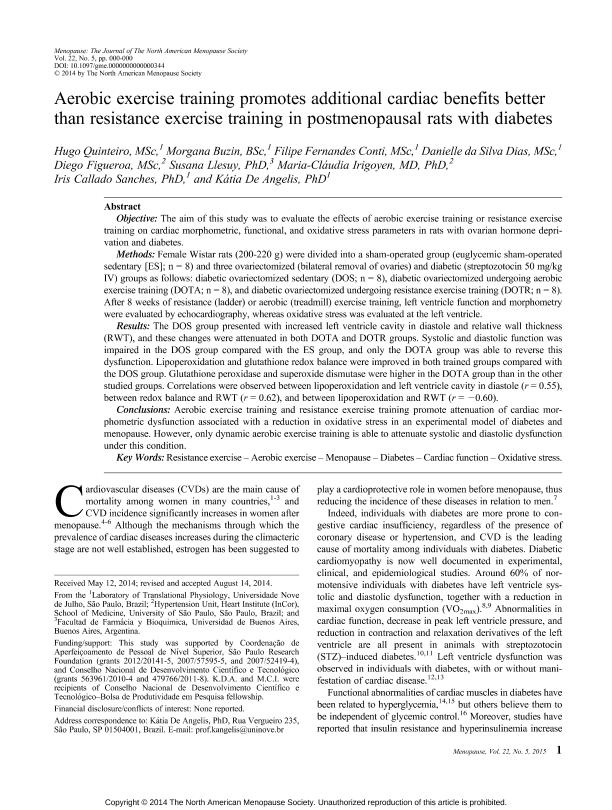Artículo
Aerobic exercise training promotes additional cardiac benefits better than resistance exercise training in postmenopausal rats with diabetes
Quinteiro, Hugo; Buzin, Morgana; Fernandes Conti, Filipe; Silva Dias, Danielle da; Figueroa, Diego; Llesuy, Susana Francisca ; Irigoyen, Maria Claudia; Callado Sanches, Iris; De Angelis, Kátia
; Irigoyen, Maria Claudia; Callado Sanches, Iris; De Angelis, Kátia
 ; Irigoyen, Maria Claudia; Callado Sanches, Iris; De Angelis, Kátia
; Irigoyen, Maria Claudia; Callado Sanches, Iris; De Angelis, Kátia
Fecha de publicación:
05/2014
Editorial:
Lippincott Williams
Revista:
Menopause
ISSN:
1072-3714
Idioma:
Inglés
Tipo de recurso:
Artículo publicado
Clasificación temática:
Resumen
OBJECTIVE: The aim of this study was to evaluate the effects of aerobic exercise training or resistance exercise training on cardiac morphometric, functional, and oxidative stress parameters in rats with ovarian hormone deprivation and diabetes.
METHODS: Female Wistar rats (200-220 g) were divided into a sham-operated group (euglycemic sham-operated sedentary [ES]; n = 8) and three ovariectomized (bilateral removal of ovaries) and diabetic (streptozotocin 50 mg/kg IV) groups as follows: diabetic ovariectomized sedentary (DOS; n = 8), diabetic ovariectomized undergoing aerobic exercise training (DOTA; n = 8), and diabetic ovariectomized undergoing resistance exercise training (DOTR; n = 8). After 8 weeks of resistance (ladder) or aerobic (treadmill) exercise training, left ventricle function and morphometry were evaluated by echocardiography, whereas oxidative stress was evaluated at the left ventricle.
RESULTS: The DOS group presented with increased left ventricle cavity in diastole and relative wall thickness (RWT), and these changes were attenuated in both DOTA and DOTR groups. Systolic and diastolic function was impaired in the DOS group compared with the ES group, and only the DOTA group was able to reverse this dysfunction. Lipoperoxidation and glutathione redox balance were improved in both trained groups compared with the DOS group. Glutathione peroxidase and superoxide dismutase were higher in the DOTA group than in the other studied groups. Correlations were observed between lipoperoxidation and left ventricle cavity in diastole (r = 0.55), between redox balance and RWT (r = 0.62), and between lipoperoxidation and RWT (r = -0.60).
CONCLUSIONS: Aerobic exercise training and resistance exercise training promote attenuation of cardiac morphometric dysfunction associated with a reduction in oxidative stress in an experimental model of diabetes and menopause. However, only dynamic aerobic exercise training is able to attenuate systolic and diastolic dysfunction under this condition.
Archivos asociados
Licencia
Identificadores
Colecciones
Articulos(IBIMOL)
Articulos de INSTITUTO DE BIOQUIMICA Y MEDICINA MOLECULAR
Articulos de INSTITUTO DE BIOQUIMICA Y MEDICINA MOLECULAR
Citación
De Angelis, Kátia; Callado Sanches, Iris; Irigoyen, Maria Claudia; Llesuy, Susana Francisca; Figueroa, Diego; Silva Dias, Danielle da; et al.; Aerobic exercise training promotes additional cardiac benefits better than resistance exercise training in postmenopausal rats with diabetes; Lippincott Williams; Menopause; 22; 5; 5-2014; 534-541
Compartir
Altmétricas



